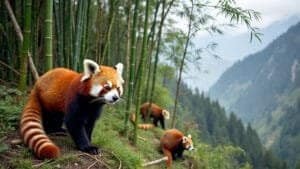Introduction
Red pandas play an important role in shaping the bamboo forests they inhabit. As their primary food source, bamboo forms the basis of red panda diets, with pandas consuming large quantities of shoots, leaves, and stems. This continuous feeding influences the natural regrowth cycle of bamboo, maintaining a balanced ecosystem and preventing overgrowth
The interaction between red pandas and bamboo helps ensure that these forests remain healthy and sustainable, benefiting not only the pandas but also the other species that share their habitat
This article explores how red pandas influence bamboo growth, the ecological effects of their foraging behavior, and the broader role they play in maintaining bamboo forest ecosystems
Red Panda Feeding Behavior and Bamboo Growth
Red pandas rely heavily on bamboo as their primary food source, and their feeding behavior directly influences bamboo growth and regeneration in their habitats. While bamboo makes up about 85-95% of a red panda’s diet, the way red pandas consume this resource plays a significant role in maintaining a healthy balance within bamboo ecosystems
By selectively feeding on young shoots and leaves, red pandas help control bamboo growth and ensure that the forest remains a thriving environment for both the pandas and other species that share the habitat
How Red Pandas Select Bamboo Shoots and Leaves
Red pandas are highly selective feeders when it comes to bamboo. They tend to prefer the tender, nutrient-rich bamboo shoots and young leaves, which are easier to digest and offer the highest nutritional value
This selective feeding helps regulate the growth of bamboo, as the pandas target the younger, rapidly growing parts of the plant. By feeding on shoots before they fully mature, red pandas influence the overall structure and density of the bamboo forest
This selective feeding behavior plays a role in preventing the overgrowth of bamboo. Bamboo species in red panda habitats grow rapidly, and without natural consumers like red pandas, the bamboo could dominate the landscape, outcompeting other plant species
Red pandas contribute to a more balanced ecosystem by ensuring that bamboo growth remains controlled, allowing other plants to coexist in the forest
Research by Wei et al. (1999) explains that red pandas have a particular preference for certain species of bamboo, which further shapes the composition of bamboo forests. Their selective feeding patterns can influence the dominance of specific bamboo species, creating a more diverse and resilient forest ecosystem
Impact of Continuous Feeding on Bamboo Regeneration
The continuous feeding on bamboo by red pandas stimulates the natural regeneration process. Bamboo plants are known for their resilience, and when red pandas feed on the shoots and leaves, they trigger a response in the plant that promotes new growth
This process helps maintain a cycle of regeneration, ensuring that bamboo forests remain a renewable resource that can support red panda populations over the long term
Bamboo plants often grow back rapidly after being grazed, and the act of pruning by red pandas—similar to how pruning can stimulate growth in garden plants—encourages healthier and more vigorous bamboo regrowth
This process helps prevent the aging and die-off of bamboo stands, keeping the forest vibrant and capable of supporting the wide array of species that depend on it
Studies by Qi et al. (2009) have shown that areas with active red panda populations tend to have healthier bamboo regeneration rates compared to areas where pandas are absent or their numbers have declined
This suggests that red pandas play a key role in maintaining the sustainability of bamboo forests through their feeding behavior
Seasonal Variation in Red Panda Bamboo Consumption
Red panda feeding habits and their impact on bamboo growth vary with the seasons. During the warmer months, when bamboo shoots are more abundant, red pandas focus on the soft, nutrient-rich parts of the plant, such as the shoots and young leaves
This seasonal feeding behavior helps prevent the over-maturity of bamboo and encourages new growth during the peak growing season
In the colder months, when bamboo shoots are less available, red pandas shift their diet to include the tougher, older leaves and stems of bamboo. This helps manage the forest’s bamboo supply by ensuring that older growth is utilized and not left to crowd out new plants
This seasonal adjustment in their diet ensures that bamboo forests remain balanced throughout the year, with red pandas acting as natural regulators of bamboo growth cycles
Research by Glatston (2011) highlights the importance of seasonal variation in red panda diets, showing how their ability to adapt to different parts of the bamboo plant helps sustain the overall health and productivity of the forest ecosystem
The Role of Red Pandas in Bamboo Forest Ecosystems
Red pandas play an important ecological role in bamboo forest ecosystems. By feeding on bamboo and interacting with their environment, they help regulate the growth and composition of these forests, creating a balance that benefits both bamboo and other species within the ecosystem
Red pandas are not only consumers of bamboo but also key contributors to the maintenance and sustainability of bamboo-dominated habitats. Their presence helps control bamboo overgrowth, supports biodiversity, and fosters a healthy and dynamic forest ecosystem
Red Pandas and the Balance of Bamboo Species
In the regions where red pandas live, several species of bamboo thrive, each with different growth rates and ecological niches. Red pandas contribute to maintaining a balance among these species through their selective feeding habits
They tend to favor certain bamboo species over others, targeting the young shoots and leaves of particular varieties that are more nutritious or abundant during specific seasons
This selective feeding can prevent any one bamboo species from dominating the forest, allowing a more diverse range of bamboo plants to coexist
This diversity is critical to the overall health of the ecosystem, as it provides a variety of food and habitat options for different wildlife species that share the forest with red pandas. By controlling the growth of dominant bamboo species, red pandas help maintain a more balanced and resilient ecosystem
Research by Wei et al. (1999) suggests that red pandas play a key role in shaping bamboo species composition, as their feeding preferences can influence which species thrive and which are kept in check. This balance is vital for maintaining the diversity and health of the forest
Bamboo Growth Cycles and Red Panda Foraging Patterns
Bamboo is a highly dynamic plant that follows specific growth cycles, with periods of rapid growth followed by dormancy or flowering events. Red pandas have adapted to these cycles, adjusting their foraging behavior to match the availability of bamboo shoots and leaves
During periods of rapid growth, when young bamboo shoots are abundant, red pandas focus their feeding on these new growths, which helps stimulate the bamboo’s regenerative abilities
This interaction between red panda foraging and bamboo growth cycles creates a symbiotic relationship that benefits both the pandas and the forest
As red pandas consume bamboo shoots, they promote new growth, which not only ensures a continuous food supply but also prevents older, less productive bamboo from overcrowding the forest. This cyclical relationship supports the long-term sustainability of bamboo forests
Studies by Qi et al. (2009) show that red pandas’ feeding behavior is closely tied to bamboo’s natural growth cycles, with pandas playing an active role in promoting healthy, sustainable bamboo forests
How Red Pandas Help Prevent Bamboo Overgrowth
Without natural consumers like red pandas, bamboo forests have the potential to grow unchecked, leading to overgrowth that can stifle other plant species and reduce biodiversity
Red pandas help regulate this growth by feeding on bamboo shoots and leaves, ensuring that bamboo does not become overly dominant in the forest. This natural regulation allows other plant species to thrive, contributing to a more diverse and balanced ecosystem
In addition to preventing overgrowth, red pandas help manage bamboo populations by consuming the faster-growing or more aggressive bamboo species, which might otherwise outcompete slower-growing varieties. This selective feeding reduces competition among bamboo species and ensures that the forest remains a habitat for a wide range of flora and fauna
Research by Yonzon and Hunter (1991) underscores the importance of red pandas in controlling bamboo overgrowth, noting that their feeding patterns help maintain the balance of the ecosystem and prevent bamboo monocultures from developing
Long-Term Effects of Red Panda Foraging on Bamboo Health
The foraging habits of red pandas have long-term impacts on the health and sustainability of bamboo forests. Red pandas play a vital role in ensuring that bamboo continues to regenerate and maintain its role as a key component of forest ecosystems
By selectively feeding on bamboo and influencing its growth cycles, red pandas contribute to the long-term vitality of bamboo populations, helping forests remain diverse and resilient
Bamboo Regrowth After Red Panda Consumption
Red pandas’ feeding behavior, particularly their preference for bamboo shoots and young leaves, stimulates regrowth in bamboo plants
When red pandas consume bamboo shoots, they prune the plant in a way that encourages new growth, similar to how pruning can enhance the productivity of other plants. This constant interaction between red pandas and bamboo ensures that bamboo plants are continuously renewing, which supports the overall health of the forest
Bamboo plants are known for their rapid growth and resilience, often recovering quickly after being grazed by red pandas. This regrowth provides a sustainable food source for red pandas, as well as other herbivores that rely on bamboo
The ability of bamboo to regenerate after consumption ensures that red pandas and other species can coexist without exhausting this critical resource
Research by Qi et al. (2009) demonstrates that bamboo forests in areas with active red panda populations show higher rates of regrowth compared to regions where red pandas are absent. This indicates that red pandas play a crucial role in maintaining bamboo forest dynamics by promoting continuous regeneration
Red Pandas and Forest Biodiversity Maintenance
Red pandas indirectly contribute to forest biodiversity by regulating bamboo growth, which in turn supports a wider range of plant and animal species
Without red pandas to help control bamboo overgrowth, bamboo can dominate the forest floor, limiting the growth of other plants that are essential to the forest ecosystem. By consuming bamboo shoots and leaves, red pandas create space and resources for other plant species to thrive, which in turn supports a variety of wildlife
This balance between bamboo and other plant species is essential for maintaining the overall health of the forest. A diverse range of plant species provides food and shelter for numerous animals, from insects to birds and small mammals
Red pandas’ role in managing bamboo growth helps preserve this biodiversity, ensuring that the forest remains a complex and interconnected ecosystem
Studies by Wei et al. (1999) highlight the ecological importance of red pandas in promoting forest biodiversity. The researchers found that forests with healthy red panda populations tend to have higher levels of plant and animal diversity, indicating the broader impact of red pandas on forest ecosystems
Influence of Red Panda Population Fluctuations on Bamboo
Fluctuations in red panda populations can have significant effects on the health of bamboo forests. When red panda populations decline due to habitat loss, poaching, or other factors, the absence of their foraging pressure can lead to unchecked bamboo growth
This can result in bamboo overgrowth, which may crowd out other plant species and reduce the overall biodiversity of the forest
On the other hand, healthy red panda populations help maintain a balance within the bamboo forest, preventing any one species of bamboo from becoming overly dominant. This balance is crucial for the long-term sustainability of the forest, as it ensures that the ecosystem remains diverse and capable of supporting a variety of wildlife
Research by Glatston (2011) suggests that fluctuations in red panda populations can disrupt the balance of bamboo forests, with negative consequences for the broader ecosystem
The study emphasizes the importance of red pandas in maintaining the health and stability of bamboo-dominated habitats
Ecological Benefits of Red Pandas in Bamboo Habitats
Red pandas not only influence the growth and regeneration of bamboo, but they also provide broader ecological benefits that enhance the health and sustainability of bamboo-dominated ecosystems
Their role as a key species in these habitats extends beyond simply consuming bamboo; red pandas contribute to forest biodiversity, support the ecosystem’s balance, and help maintain the overall resilience of the forests in which they live
Red Pandas as Key Species in Bamboo-Dominated Ecosystems
Red pandas are considered a key species in the ecosystems they inhabit because their behavior has significant effects on the structure and function of bamboo forests. By regulating bamboo growth through their selective feeding habits, red pandas help maintain a balance within the forest that supports other plant and animal species
This key role makes them critical to the health of the ecosystem, as their presence ensures that bamboo forests do not become overgrown and lose their ecological diversity
Red pandas’ influence extends to other species that share their habitat. Their ability to prevent bamboo from over-dominating the landscape creates space for a variety of other plants to grow, which in turn provides food and shelter for different animals, including birds, small mammals, and insects
As a result, red pandas indirectly support the survival of other species, making them a crucial part of the forest’s ecological web
Research by Yonzon and Hunter (1991) emphasizes the role of red pandas as key species in maintaining the ecological balance of bamboo forests. The study shows that ecosystems with thriving red panda populations are more diverse and stable, highlighting the species’ broader impact on the environment
How Red Pandas Enhance Bamboo Forest Sustainability
Red pandas play a significant role in sustaining the long-term health of bamboo forests. By continuously feeding on bamboo and encouraging its regrowth, red pandas promote a cycle of renewal that ensures bamboo remains a renewable resource
This regenerative process helps bamboo forests stay productive and resilient, making them better able to withstand environmental pressures such as climate change, disease, or natural disturbances
Bamboo plants, while fast-growing, can become old and less productive if left unchecked. Red pandas’ foraging on younger shoots prevents bamboo stands from becoming overgrown and stagnant, keeping the ecosystem dynamic and capable of regenerating over time
This contribution to the sustainability of bamboo forests is critical not only for red pandas but also for the other species that rely on the bamboo ecosystem for survival
Research by Qi et al. (2009) highlights the importance of red pandas in sustaining bamboo forests, showing that areas with active red panda populations are healthier and more resilient than areas where pandas are absent. This suggests that red pandas play an integral role in the long-term sustainability of bamboo-dominated habitats
The Indirect Effects of Red Pandas on Other Forest Species
Red pandas contribute to the overall biodiversity of bamboo forests by influencing the availability of resources for other species. By consuming bamboo and helping regulate its growth, red pandas create opportunities for other plant species to thrive, which in turn supports a variety of wildlife
This indirect effect on biodiversity is one of the many ways red pandas enhance the ecological health of their habitats
For example, when red pandas feed on bamboo, they create gaps in the bamboo canopy that allow sunlight to reach the forest floor. This increased light availability supports the growth of understory plants, which provide food and shelter for other animals, such as insects, birds, and small mammals
In this way, red pandas indirectly contribute to the survival of other species by shaping the structure of the forest
In addition, red pandas’ role in maintaining bamboo forests helps sustain the overall ecosystem services that forests provide, such as water retention, carbon storage, and soil stabilization. These services benefit not only the species living within the forest but also the surrounding human communities that depend on healthy forests for resources and environmental stability
Research by Wei et al. (1999) underscores the indirect ecological benefits of red pandas, showing that their presence supports a more diverse and resilient forest ecosystem. The study highlights the broader environmental importance of red pandas in maintaining the ecological balance of bamboo habitats
Conclusion
Red pandas are critical to the health and sustainability of bamboo-dominated ecosystems. Through their selective feeding behavior, they help regulate bamboo growth, prevent overgrowth, and promote natural regeneration
By consuming bamboo shoots and leaves, red pandas ensure that bamboo forests remain dynamic and capable of supporting a wide range of plant and animal species. This balance not only benefits red pandas but also fosters biodiversity and resilience within the forest ecosystem
Their role as key species extends beyond their immediate feeding habits. Red pandas contribute indirectly to the overall ecological health of the forest by creating opportunities for other species to thrive and by supporting ecosystem services such as water retention and carbon storage. Their influence on bamboo forests helps maintain the delicate balance needed to keep these ecosystems vibrant and productive
Long-term conservation of red pandas is essential for the continued sustainability of bamboo forests. Protecting red pandas means preserving the intricate relationships they have with their environment, ensuring that these forests can continue to support not only red pandas but also the entire ecosystem
The ecological benefits that red pandas provide highlight their vital role in maintaining the balance and health of bamboo-dominated habitats, making their conservation a priority for the future of these unique ecosystems











